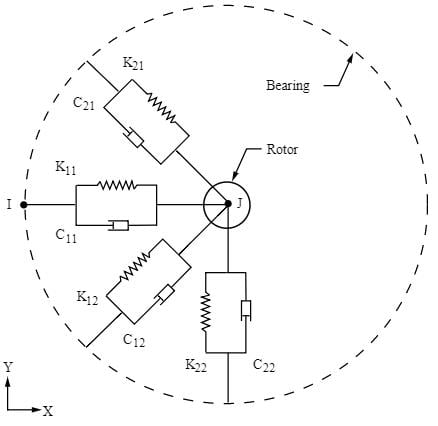-
-
September 19, 2018 at 1:05 pm
langea
Subscriber
Hello.
I want to analyze rotordynamics with fluid bearings. I have a working APDL script, however I would like to perform the same analysis using Workbench. My problem is as follows:
Since my bearing characteristics are both speed-dependent and length-dependent, I must discretize the whole bearing with 51 bearing elements. While this works neatly in APDL, creating named sections and manually entering all the coefficients is a rather long process.
Is there a way to implement the APDL commands in Workbench?
In /prep7 I define the nodes for the bearings. In /solu I use a loop to import the bearing coefficents corresponding to the respective rotational velocity. So, I think I have to actually insert two APDL command blocks.
I have tried to insert a command block right after I define my connections and insert the commands to create the bearing nodes:
L1 = 7.5e-3
L2 = 18e-3 + L1
ET,2,COMBI214,,0,1 !Unsymmetric bearing in XY-Plane
bearing_opt = 3
TYPE,2
numstr,elem,100001
*if,bearing_opt,eq,3,then
*do,i,1,n,1
n,100000+i,0,5e-3,L1+((L2-L1)/(n-1))*(i-1)!nodes for the bearing stator
REAL,i!assigning real constants
e,node(0,0,L1+((L2-L1)/(n-1))*(i-1)),100000+i!assigning bearing elements over 2 nodes each
*enddo
*endif
In the solution command block I must get the current rotational velocity and then import the corresponding bearing coefficients. The bearing coefficient files are labeled by the rotational velocity in rounds per second. So a rotational velocity of 600 rpm (10 Hz) is labeled as “ansys_bearing_manual_10.
! Get current rotational velocity in rpm, devide by 60 to get rotational frequency
bearing_opt = 3
*if,bearing_opt,eq,3,then
/input,'ansys_bearing_manual_%current rotational velocity in Hz%','inp','P:Simulation (aktuell)ansysMagnetansys_bearings_rillen',2,0
cmomega,Rotor,,,f(j)*2*pi
*endif
1.) I am not sure if my approach is correct and possible.
2.) I do not know how to get the rotational velocity.
I am grateful for help of any sort (code, command, example,&hellip
 . I have attached the APDL Input script, the bearing coefficient files and a dummy Workbench project to implement the commands. If you need further information, please tell me.
. I have attached the APDL Input script, the bearing coefficient files and a dummy Workbench project to implement the commands. If you need further information, please tell me.
Thanks in advance and best regards
-
September 19, 2018 at 3:37 pm
Sandeep Medikonda
Ansys EmployeeHi Iangea,
You can write out the database using the CDWRITE command and bring it into Mechanical using External Model. Additionally, if everything you want isn't imported, then you can use command snippets to implement the code you need.
Regards,
Sandeep
-
September 20, 2018 at 7:06 am
langea
SubscriberHi SandeepMedikonda,
Using the External Model does not give me the ability to easily link analysis systems using a GUI. Even though I already looked at an input file for a prestressed modal analysis and used the External model for post-processing in Mechanical Workbench, my goal is to switch to Workbench and implement command snippets.
Regarding code snippets, I think I got the first code snippet to work by leaving out the element type number:
ET,,COMBI214,,0,1 !Unsymmetric bearing in XY-Plane
as it defaults to 1+ current maximum.
For the second code snippet, I thought about getting the current rotational velocity by using the *Get command, but I don't know how exactly.
*GET,frpm,??? ! Get current rotational velocity
fHz = frpm/60
bearing_opt = 3
*if,bearing_opt,eq,3,then
/input,'ansys_bearing_manual_%fHz%','inp','P:Simulation (aktuell)ansysMagnetansys_bearings_rillen',2,0
*endif
How can I get the rotational velocity of the current step?
Best regards
-
September 20, 2018 at 1:26 pm
jpasquerell
Ansys Employee
This is not a documented command so you should independently confirm that it is working for your model.
*GET,OMEGAX,common,,acelcm,,real,31
*GET,OMEGAY,common,,acelcm,,real,32
*GET,OMEGAZ,common,,acelcm,,real,33 -
September 21, 2018 at 9:10 am
langea
SubscriberThanks to both of you. Although the command partially works, I could not get the comment and my inputs to work in a solution loop.
I have decided to stick to APDL as it gives me more flexibility and use the suggested external model method to post process my results in Workbench. Originally, I could not to that, since that procedure apparently does not work with SOLID272 elements. But since I want to incorporate pre-stress effects, I must switch from those elements regardless.
-
July 30, 2019 at 1:13 pm
Sankar93
SubscriberI want to know about the physical meaning of stiffness coefficients in COMBI214 elements. What does k11, k12, k21,k22 stand for?
-
July 30, 2019 at 2:48 pm
-
July 30, 2019 at 2:51 pm
Sankar93
SubscriberHow can i assign radial stiffness in this element
-
July 30, 2019 at 5:08 pm
peteroznewman
SubscriberK11 and K22 are values for radial stiffness.
-
July 31, 2019 at 11:40 am
Sankar93
SubscriberThen k12 and k21 for which stiffness
-
July 31, 2019 at 2:38 pm
peteroznewman
SubscriberSankar93, did you look in the ANSYS Help system?
Use this URL for help in ANSYS 2019 R2, by following these instructions.
https://ansyshelp.ansys.com/account/secured?returnurl=/Views/Secured/corp/v194/ans_thry/thy_el214.html
I copy from that page...
-
August 1, 2019 at 2:42 pm
Sankar93
Subscriberhow to assign the axial and torsional stiffness in the bearing connection COMBI214
-
August 1, 2019 at 2:49 pm
peteroznewman
SubscriberRead the help I pointed out above.
-
- The topic ‘Import Bearing coefficients via APDL command’ is closed to new replies.



-
3582
-
1193
-
1086
-
1063
-
952

© 2025 Copyright ANSYS, Inc. All rights reserved.











